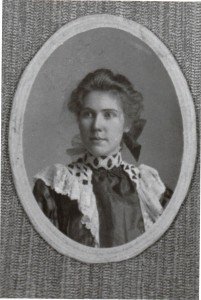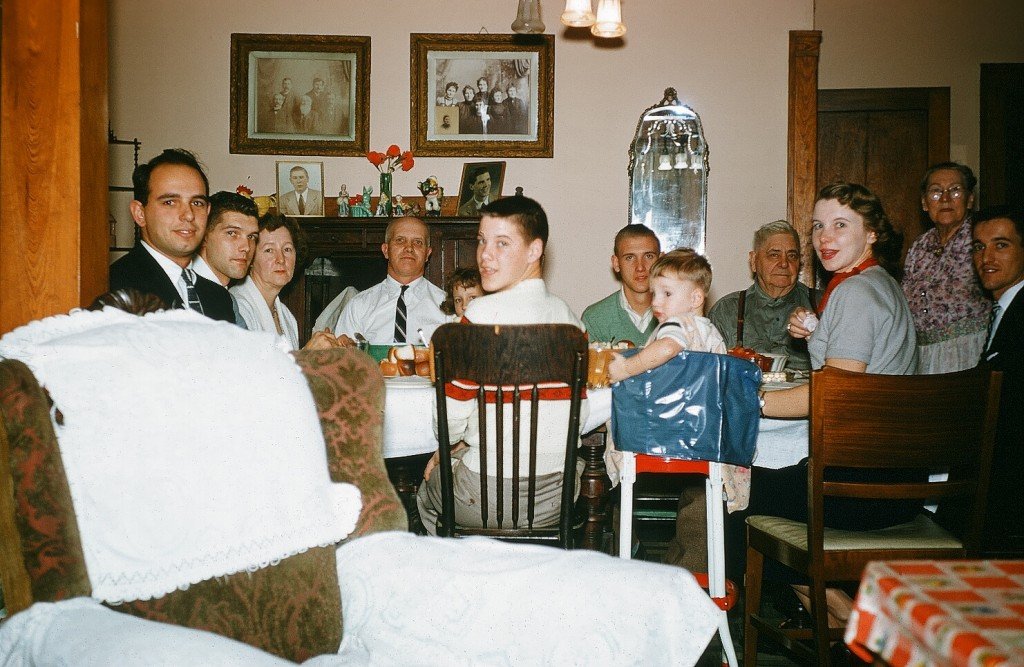First some historical background before writing about our first English ancestor immigrants. They were Walter & Ann Margaret Palmer and their five children: Grace, William Jonah, Elizabeth and John who lived at Nottinghamshire, England. Ann Margaret died before Walter and their children emigrated from the port of Gravesend, England aboard the Four Sisters in 1629 as part of the Higginson Fleet.
Walter & Ann Margaret Palmer, are Margie Tollas Bernard’s (as well as those of her brother Charles Tollas and sister Carolyn Tollas Knapp) maternal 9th great-grandparents; Don & Mark’s 10th great-grandparents, Mark Bryan, Christopher, Patric & Kyle’s 11th great-grandparents; and 12th great-grandparents to Mark Bryan & Michelle’s Holdin & Caleigh, and Patric & Jessica’s Nolan.
This is my Palmer lineage beginning with Walter:
9th great-grandfather
son of Walter Palmer
daughter of Jonah Palmer 1st
son of Hannah Palmer
son of Ephraim French 1st
daughter of Ephraim French 2nd
son of Mary French
son of Stephen Briggs 2nd
daughter of Ira R. Briggs
daughter of Fannie E Briggs
daughter of Jennie Augusta (Waldron) Bennett
![]() In 1620, the stockholders of The Plymouth Council of England were granted the right by English King James I to form the Plymouth Colony in what was known as New
In 1620, the stockholders of The Plymouth Council of England were granted the right by English King James I to form the Plymouth Colony in what was known as New  England. They in turn granted the Pilgrims the right to settle and they arrived at Plymouth on September 11, 1620.
England. They in turn granted the Pilgrims the right to settle and they arrived at Plymouth on September 11, 1620.
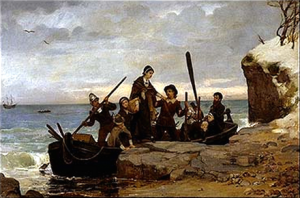
The next significant settlement was that of John Endicott who was one of seven signatories to a colonizing land grant provided by Robert Rich, the Second Earl of Warwick on behalf of the Plymouth Council of New England. Endicott was chosen to lead the expedition to New England and sailed aboard the Abigail with fifty or so colonizers and servants on June 20, 1628, arriving in September. The settlement they organized was first called Naumkeag, after the local Indian tribe, but eventually renamed Salem in 1629 and Endicott became the first acting governor of New England.
Arrival of our Palmer Ancestors at New England
The following year, Endicott invited Francis Higginson, a Puritan minister [follower of John Calvin], to bring settlers to Salem. Higginson agreed and obtained a Royal Charter from King Charles I of England to form a colony. The Higginson Fleet set sail on the May 1,1629 with the following ships: George Bonaventure; Talbot; Lyon’s Whelp; Four Sisters; Pilgrim and Mayflower (a different ship than the Pilgrim’s Mayflower). The GB arrived June 22 and the rest on 29 June 1629. Walter Palmer and his five children were on the Four Sisters.
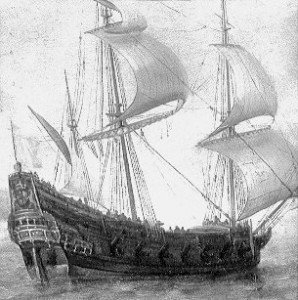
The Higginson Fleet brought with them 115 head of cattle, as well as horses and mares, cows and oxen, 41 goats, some conies (rabbits), along with all the provisions needed for setting up households and surviving till they could get crops in. They would have to build their lodgings for the coming winter from scratch. These were the first settlers of the Massachusetts Bay Colony, the main body would start coming in 1630 on the Winthrop Fleet. The Higginson Fleet arrived in Salem harbor on the 24 June 1629, and was greeted by a small group of settlers, led by John Endicott. This marks the second phase of what has become known as The Great Migration Begins: Immigrants to New England between 1620–1633
Not all these immigrants remained in Salem, as recounted by Higginson in his New England Plantation:
“During the last week of June, or the first week of July, 1629, Mr. Thomas Graves, Rev. Francis Bright, with a part of the emigrants, settled in Charles-town. Describing the colony Higginson says:– There are in all of vs [us] both old and new planters about three hundred, whereof two hundred of are settled at Neihum-kek, now called Salem: and the rest have planted themselves at Masathulets [Massachusetts] Bay, beginning to build a towne there which wee doe call Cheriton, or Charles Towne.”
In the History of Charleston, Massachusetts is the record of the proceedings of the first town committee which lists the names of the settlers: Ralph Sprague; Richard Sprague; William Sprague; John Meech; Simon Hoyte; Abraham Palmer; Walter Palmer; Nicholas Stower; John Stickline, Mr. Graves and Rev. Bright their minister. Also present was Thomas Walford Smith who had lived there alone for several years.
“This newly created town committee then agreed: That this place on the north side of the Charles River, by the natives called Mishawum, shall be called Charlestown, which was also confirmed by Mr. John Endicott, governor.
“It is jointly agreed ad [and] concluded by the inhabitants of this town, that Mr. Graves do model and lay out the form of the town, with streets about the Hill, which was accordingly done and approved by the Governor.
“It is jointly agreed and concluded, that each inhabitant have a two acre lot to plant upon, and all to fence in common; which was accordingly by Mr. Graves measured out unto them.
“Upon which Ralph Sprague and others began to build there [their] houses, and to prepare fencing for their lots, which was afterwards set up almost in a semi-circular form on the south and south-east side of that field laid out to them, which lies situated on the north-west side of the Town Hill.
“Walter Pamer [Palmer] and one or two more, shortly afterwards began to build in a straight line upon their two acre lots on the east side of the Town Hill, and set up a slight fence in common that ran up to Tho. Walford’s fence, and this was the beginning of that east field.”
Abraham Palmer, a merchant, was one of the prominent men of the colony. He … came over in Higginson’s fleet in 1629, and arrived in this town [Charlestown, Massachusetts] with Graves. He died at Barbados, about 1653. His wife’s name was Grace and apparently they had no children. As a merchant Abraham was engaged in trade between the New England Colony and Barbados. Barbados became an English Colony in 1627 dedicated to sugar plantations and slave trade: One wonders what Abraham traded in?
Walter Palmer is mentioned in the first record of the Massuchetts Bay Court of Assistants on September 28, 1630, in a jury called to make a determination into the death of Austin Bratcher a servant of one of the settlers, William Cheseborough. It found “that the strokes given by Walter Palmer, were occasionally e [the] means of the death of Austin Bratcher, and so to be manslaughter.” Walter was tried at the next Court in October, and acquitted. Later, he was made freeman 1631, [citizen] and constable in 1636.

In 1632, Walter married his second wife, Rebecca Short. They had five sons and two daughters: Hannah, Elihu, Nehemiah, Moses, Benjamin, Gersham, and Rebecca.
In 1642, he moved his family to Rehoboth, Massachusetts, of which he was one of the founders. He was chosen to represent that town at the Massachusetts Bay General Court.

In 1652, Walter & Rebecca moved to Stonington, Connecticut of which he is a founder. This commemorative stone was erected, August 31, 1899, by the Wequetequock Burial Ground committee at Stonington to honor its four founders: William Cheseborough, Thomas Minor, Thomas Stanton and Walter. Minor married Walter’s daughter Grace.[The surname Minor was changed to Miner and remains thus in official documents] The wording on Walter’s side of this stone states:
“Walter Palmer one of the founders of Stonington. Emigrated to New England in 1629 and settled in Charleston, Mass. Became a Freeman May 18, 1631, and united with the Charlestown Church June 1, 1633. Removed to Rehoboth Plymouth Colony in 1642 and represented that town in the General Court. Came to Stonington in 1652 and lived here until his death Nov. 10, 1661. At his home near this spot was held the first religious service between the Thames River and Narragansett Bay.”

In his will, Walter left property to his sons John, William, Gersham, Elihu, Nehemiah, Moses, Benjamin; and daughters Grace, Hannah, and Rebecca. He left to Jonah, who was already residing there, his “lot at Seeconk” which became part of Rehoboth .
As reported in the New York Tribune, August 12, 1881, Walter Palmer ancestors made a pilgrimage to his last residence at Stonington.
“Yesterday morning about half-past nine, more than five hundred of the [Palmer] family went by special train to view the site of the house in which their principal ancestor lived during a part of his residence in Pawcatuck (Stonington) and also the ancient Wequetequock Burying Ground where he was buried. These are situated about two and a half miles from the center of the borough. A number also went out by carriage and a few walked to….Walter Palmer’s estate, embracing about 1200 acres, [which] lay on the east side of the cove, and extended from its upper end down to the ocean. The burying ground was set apart by him and originally bordered on the cove. Now, however, a road runs along the shore and is divided from the burial plot by a substantial stone fence. It is not an absolute certainty that Walter Palmer and his wife Rebekah are buried here, but it is believed his bones lie under a huge “hog back” stone….There is no inscription or mark whatever upon the stone which is 6 ft. 11 in. in length—the reputed height of Walter Palmer, whose weight was 300 pounds—and must weight at least a ton. One reason why this believed to be the grave of this ancestral Palmer is that a stone marking the burial spot of his son Nehemiah stands along side of the stone already described. Another of Walter Palmer’s children, his oldest daughter, Grace, who married Thomas Minor, is also buried a rod or two away, together with her husband. A flat stone covers the common grave, bearing the figure “1690”. His son Elihu, who died in 1655 is buried here, and the first wife of his son Gershom [Ann Dennison].”
President Ulysses S. Grant had agreed to attend the pilgrimage but had to cancel due to the death of his youngest brother Orvil Lynch Grant.
Through the lineage of Walter’s eldest child Grace, who married Thomas Miner, I find I that General and President Ulysses Simpson Grant is my seventh cousin, three times removed.

Furthermore, Walter’s daughter Hannah by his second wife married John Fish whose ancestors are also famous in U.S. history; two of whom, brothers Hamilton & Nicholas Fish are friends of mine from our Washington, DC days in the 1980s. One of their ancestors, whom I believe is a great-grandfather, also named Hamilton Fish, was President Grant’s Secretary of State from 1869 to 1877.
This link provides Walter Palmer’s descendants, through the fifth-generation.



 Eight children were born in Michigan to Ira R and Eliza Briggs; the oldest at
Eight children were born in Michigan to Ira R and Eliza Briggs; the oldest at 



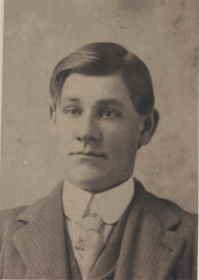

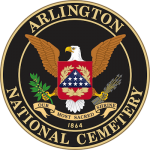 with military honors on Patton Drive at Arlington National Cemetery. Uncle Victor served under General George S. Patton during WW II but didn’t like him so there is a bit of irony that this was his final resting place!
with military honors on Patton Drive at Arlington National Cemetery. Uncle Victor served under General George S. Patton during WW II but didn’t like him so there is a bit of irony that this was his final resting place! 